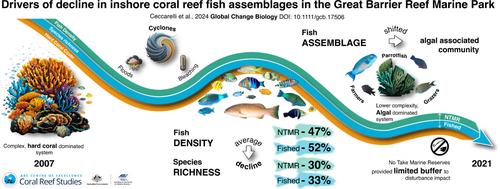当前位置:
X-MOL 学术
›
Glob. Change Biol.
›
论文详情
Our official English website, www.x-mol.net, welcomes your
feedback! (Note: you will need to create a separate account there.)
Regional‐scale disturbances drive long‐term decline of inshore coral reef fish assemblages in the Great Barrier Reef Marine Park
Global Change Biology ( IF 10.8 ) Pub Date : 2024-10-14 , DOI: 10.1111/gcb.17506 Daniela M. Ceccarelli, Murray Logan, Richard D. Evans, Geoffrey P. Jones, Marji Puotinen, Caroline Petus, Garry R. Russ, Tane Sinclair‐Taylor, Maya Srinivasan, David H. Williamson
Global Change Biology ( IF 10.8 ) Pub Date : 2024-10-14 , DOI: 10.1111/gcb.17506 Daniela M. Ceccarelli, Murray Logan, Richard D. Evans, Geoffrey P. Jones, Marji Puotinen, Caroline Petus, Garry R. Russ, Tane Sinclair‐Taylor, Maya Srinivasan, David H. Williamson

|
Anthropogenic pressure is increasing the variety and frequency of environmental disturbance events, limiting recovery and leading to long‐term declines in wild plant and animal populations. Coral reefs and associated fish assemblages are inherently dynamic due to their susceptibility to a host of disturbances, but regional‐scale nuances in the drivers of long‐term change frequently remain poorly resolved. Here, we examine the effects of multiple potential drivers of change in coral reef fish assemblages across 4 inshore regions of the Great Barrier Reef Marine Park (GBRMP), Australia, over 12–14 years (2007–2021). Each region had a unique disturbance history, in conjunction with long‐term changes in physical and habitat variables. Phases of recovery were apparent in the years between disturbance events at all locations, but these were not long enough to prevent substantial declines in reef fish density (by 33%–72%) and species richness (by 41%–75%) throughout the study period. The main drivers of change in fish assemblages varied among regions; however, the most rapid changes followed cyclone and flood events. Limited recovery periods resulted in temporal shifts in fish species composition from typically coral‐associated to algae‐associated. Most trophic groups declined in density except farmers, grazers, omnivores and parrotfish. No‐take marine reserves (NTMRs) had small and inconsistent effects on total fish assemblages, but delivered benefits for fishery‐targeted piscivores. Our findings suggest that coral reef responses to local stressors and cumulative escalating climate change impacts are highly variable at regional scales, and that small NTMRs are unlikely to mitigate the impacts of increasingly frequent climatic disturbances. Nearshore coral reefs worldwide are high‐value habitats that are either already degraded or vulnerable to degradation and the loss of important fish groups. Global efforts to reduce greenhouse gas emissions must be coupled with effective local management that can support the functioning and adaptive capacity of coral reefs.
中文翻译:

区域规模的干扰导致大堡礁海洋公园近海珊瑚礁鱼类群落长期下降
人为压力正在增加环境干扰事件的种类和频率,限制了恢复并导致野生动植物种群的长期下降。由于珊瑚礁和相关鱼类组合容易受到一系列干扰,因此本质上是动态的,但长期变化驱动因素的区域尺度细微差别往往仍未得到解决。在这里,我们研究了 12-14 年(2007-2021 年)澳大利亚大堡礁海洋公园 (GBRMP) 的 4 个近海地区珊瑚礁鱼类组合变化的多种潜在驱动因素的影响。每个地区都有独特的干扰历史,以及物理和栖息地变量的长期变化。在所有地点的干扰事件之间的几年中,恢复阶段都很明显,但这些阶段不足以阻止整个研究期间珊瑚礁鱼类密度(下降 33%-72%)和物种丰富度(下降 41%-75%)的大幅下降。鱼类组合变化的主要驱动因素因区域而异;然而,最迅速的变化是在飓风和洪水事件之后。有限的恢复期导致鱼类物种组成从通常与珊瑚相关的时间转变为与藻类相关的物种。除农民、食草动物、杂食动物和鹦嘴鱼外,大多数营养类群的密度下降。禁捕海洋保护区 (NTMR) 对鱼类总量的影响很小且不一致,但为以渔业为目标的食鱼动物带来了好处。我们的研究结果表明,珊瑚礁对当地压力源和累积升级的气候变化影响的反应在区域尺度上是高度可变的,并且小型 NTMR 不太可能减轻日益频繁的气候干扰的影响。 世界各地的近岸珊瑚礁是高价值的栖息地,要么已经退化,要么容易受到退化和重要鱼类群体丧失的影响。全球减少温室气体排放的努力必须与有效的当地管理相结合,以支持珊瑚礁的功能和适应能力。
更新日期:2024-10-14
中文翻译:

区域规模的干扰导致大堡礁海洋公园近海珊瑚礁鱼类群落长期下降
人为压力正在增加环境干扰事件的种类和频率,限制了恢复并导致野生动植物种群的长期下降。由于珊瑚礁和相关鱼类组合容易受到一系列干扰,因此本质上是动态的,但长期变化驱动因素的区域尺度细微差别往往仍未得到解决。在这里,我们研究了 12-14 年(2007-2021 年)澳大利亚大堡礁海洋公园 (GBRMP) 的 4 个近海地区珊瑚礁鱼类组合变化的多种潜在驱动因素的影响。每个地区都有独特的干扰历史,以及物理和栖息地变量的长期变化。在所有地点的干扰事件之间的几年中,恢复阶段都很明显,但这些阶段不足以阻止整个研究期间珊瑚礁鱼类密度(下降 33%-72%)和物种丰富度(下降 41%-75%)的大幅下降。鱼类组合变化的主要驱动因素因区域而异;然而,最迅速的变化是在飓风和洪水事件之后。有限的恢复期导致鱼类物种组成从通常与珊瑚相关的时间转变为与藻类相关的物种。除农民、食草动物、杂食动物和鹦嘴鱼外,大多数营养类群的密度下降。禁捕海洋保护区 (NTMR) 对鱼类总量的影响很小且不一致,但为以渔业为目标的食鱼动物带来了好处。我们的研究结果表明,珊瑚礁对当地压力源和累积升级的气候变化影响的反应在区域尺度上是高度可变的,并且小型 NTMR 不太可能减轻日益频繁的气候干扰的影响。 世界各地的近岸珊瑚礁是高价值的栖息地,要么已经退化,要么容易受到退化和重要鱼类群体丧失的影响。全球减少温室气体排放的努力必须与有效的当地管理相结合,以支持珊瑚礁的功能和适应能力。


















































 京公网安备 11010802027423号
京公网安备 11010802027423号